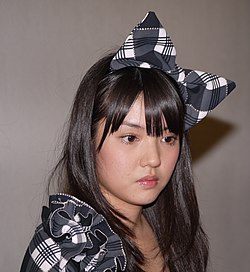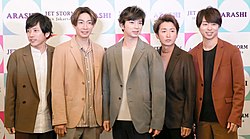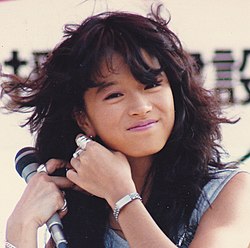Japanese idol




An idol (アイドル, aidoru, from the English word "idol") in the Japanese pop culture is a young media personality (a singer, an actor, a model, etc.). This is usually a teenager, who has a cute and innocent public image.[1] Idols are a separate category of Japanese artists.[2]
The term is commercialized by Japanese talent agents. The talent agencies hold auditions for cute boys and girls and make them stars. Idols are intended to be an ideal object of love of frenzied fans. There is also a view that the Japanese people see idols as sisters or girls next door.[3]
Japanese idol singers work across genres of the Japanese pop music. This is usually whatever is most popular at the moment. Their songs do not require great singing skills, but the artist must be beautiful, sweet and nice to sing them. In their everyday life, idols must also match the songs they sing. They must have a perfect public image and be good examples to young people.
History
The phenomenon appeared in the early 1970s. It was thanks to the popularity of young French actress Sylvie Vartan and the movie she played in called Cherchez l'idole ("Look for the Idol"). The movie came out in Japan in November 1964 under the title Aidoru o Sagase.[4] The term "idol" started being used for girls, mostly between 14 and 16, who were just beginning their path to stardom or for very young new stars.
Selective list of Japanese idol music groups
This is a selective list of Japanese idol music groups, divided by projects or talent agencies.
Japanese Idol Media
AKB48 (pictured 2010) popularized stylized school uniforms as costumes.
Nana Mizuki (pictured 2018) was one of the first voice actors marketed as an idol.
Arashi (pictured 2019) is a best-selling male idol group from Johnny & Associates.
Perfume (pictured 2015) began as a local idol group performing in Hiroshima.
Dempagumi.inc (pictured 2015) is an Akiba-kei idol group, with music and performances influenced by the otaku culture in Akihabara.
Sylvie Vartan (pictured 1966) is the codifier of the term "idol", after her appearance in the film Cherchez l'idole (1964) was well received in Japan.
Akina Nakamori (pictured 1985) is one of the idols defining the 1980s, the Golden Age of Idols.
Namie Amuro (pictured 2017) saw popularity among girls in the 1990s, despite rejecting the idol label.
Kanna Hashimoto (pictured 2014), then a member of Rev. from DVL, performed as a local idol in Fukuoka. After a fan-taken photo went viral in 2013, Rev. from DVL crossed over to mainstream media.
A crowd of wota perform wotagei at an idol concert in Akihabara in 2011.
References
- ↑ "Pop 'idol' phenomenon fades into dispersion". The Japan Times Online. Archived from the original on 2011-08-13. Retrieved 2014-05-05.
- ↑ Fanning the Flames: Fans and Consumer Culture in Contemporary Japan, ed. William W. Kelly (Albany, NY: State University of New York Press, 2004), p. 65
- ↑ William D. Hoover, Historical Dictionary of Postwar Japan (Lanham, MD: Scarecrow Press, 2011), p. 202
- ↑ "Hiroshi Aoyagi Islands of Eight Million Smiles: Idol performance and symbolic production in Japan. Harvard University Asia Center, 2005. ISBN 978-0-674-01773-3. Introduction, p. 5" (PDF). Harvard University Faculty of Arts and Sciences. Archived (PDF) from the original on 2012-07-06. Retrieved 2014-05-05.
- ↑ "AKB48 │ オリコン芸能人事典-ORICON STYLE" (in Japanese). Oricon. Retrieved 2014-05-05.
{{cite web}}: CS1 maint: unrecognized language (link) - ↑ "ももいろクローバーZ │ オリコン芸能人事典-ORICON STYLE" (in Japanese). Oricon. Retrieved 2014-05-05.
{{cite web}}: CS1 maint: unrecognized language (link) - ↑ "私立恵比寿中学 │ オリコン芸能人事典-ORICON STYLE" (in Japanese). Oricon. Retrieved 2014-04-03.
{{cite web}}: CS1 maint: unrecognized language (link) - ↑ "モーニング娘。 │ オリコン芸能人事典-ORICON STYLE" (in Japanese). Oricon. Retrieved 2014-05-05.
{{cite web}}: CS1 maint: unrecognized language (link) - ↑ "℃-ute │ オリコン芸能人事典-ORICON STYLE" (in Japanese). Oricon. Retrieved 2014-05-05.
{{cite web}}: CS1 maint: unrecognized language (link) - ↑ "Berryz工房 │ オリコン芸能人事典-ORICON STYLE" (in Japanese). Oricon. Retrieved 2014-05-05.
{{cite web}}: CS1 maint: unrecognized language (link) - ↑ "スマイレージ │ オリコン芸能人事典-ORICON STYLE" (in Japanese). Oricon. Retrieved 2014-05-05.
{{cite web}}: CS1 maint: unrecognized language (link) - ↑ "Juice=Juice │ オリコン芸能人事典-ORICON STYLE" (in Japanese). Oricon. Retrieved 2014-05-05.
{{cite web}}: CS1 maint: unrecognized language (link) - ↑ "Buono! │ オリコン芸能人事典-ORICON STYLE" (in Japanese). Oricon. Retrieved 2014-05-05.
{{cite web}}: CS1 maint: unrecognized language (link) - ↑ "Fairies │ オリコン芸能人事典-ORICON STYLE" (in Japanese). Oricon. Retrieved 2014-05-05.
{{cite web}}: CS1 maint: unrecognized language (link) - ↑ (in Japanese) アイドルグループ“9nine”がメジャーデビュー決定! (9nine) ニュース-ORICON STYLE-. Oricon. 2007-02-15. http://www.oricon.co.jp/news/entertainment/42165/.
- ↑ "武藤彩未が歌う80年代ソロアイドルの名曲が配信へ ニュース-ORICON STYLE-" (in Japanese). Oricon. 2014-05-05.
{{cite web}}: CS1 maint: unrecognized language (link)
Other websites
| Wikimedia Commons has media related to Lua error in Module:Commons_link at line 62: attempt to index field 'wikibase' (a nil value).. |









